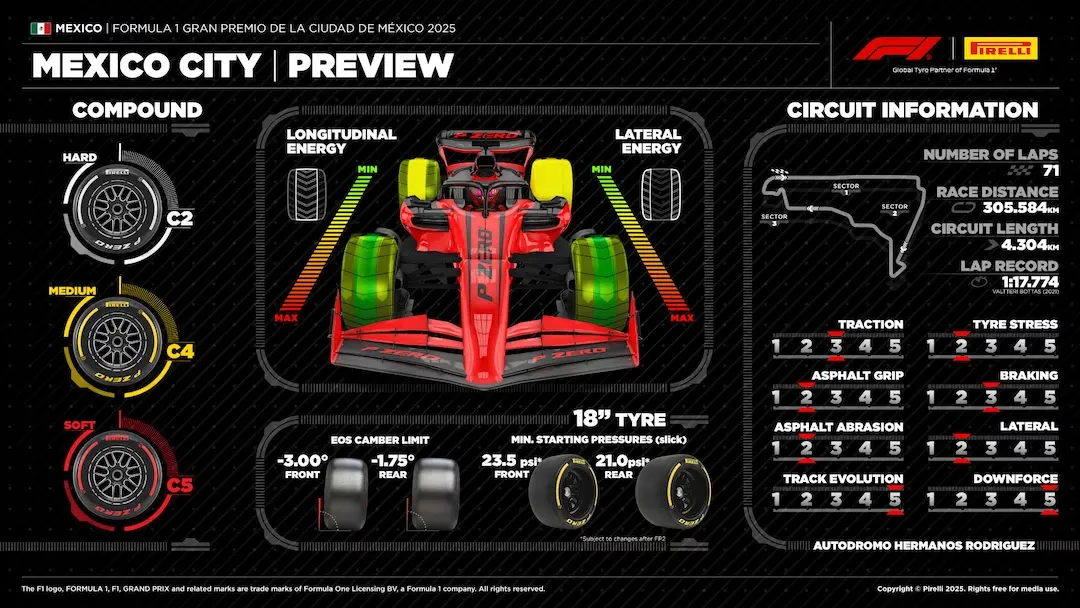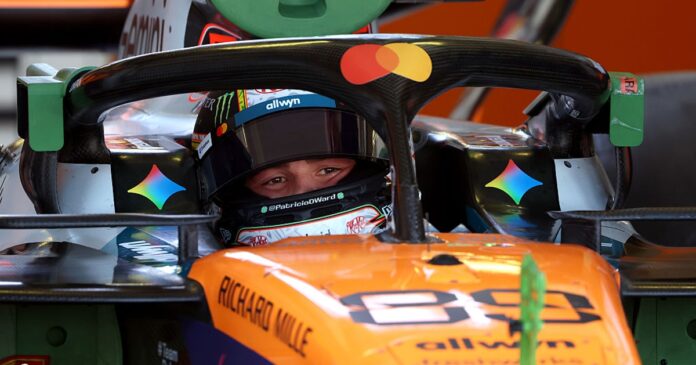Back-to-back races in Austin and Mexico City provide two special venues with huge crowds, but the track characteristics could not be more different. At over 7,200ft above sea level, the Autodromo Hermanos Rodriguez is a unique test, and this weekend’s guide to the challenge it provides is local hero Pato O’Ward, who will be taking part in FP1 again for McLaren.
“The main thing about it is the overall downforce of the car is significantly lower, so the cars will feel like they don’t have the same amount of grip as they always do. I will say the top speeds are really high as well, because of the air not being so dense. Cooling is an issue because of the altitude, so the engines struggle to breathe a little bit more.
“But in terms of the track, it’s got a lot of slow-speed, tight and twisty stuff, it’s got some very heavy braking zones, and it’s got one sector that is quite high speed.
“For me, coming from an IndyCar, it still feels very fast. To me, it doesn’t feel like it’s underwhelming. No, it’s still quite the opposite. It still feels like it can do a lot more than what I’m used to. But it’s a really nice track.
“I would say for the fans, it’s a track that you can really appreciate all the people that come, because all the sections have their own character. Everybody’s super lively and they’re excited to be here. When I finish my session, I’ll definitely wave when I get to the stadium section, because it’s quite special.
“In terms of key sections, Turns 7 through 11 are quite tricky, because you do need to trust the car. You’ve got to throw in there and believe that it’s going to do it. But it’s also an area that the car will bite if you get greedy, as we’ve seen in the past. So I would say that section is quite easily the one that can make or break your lap.
Slow and twisty corners encourage aggression, but O’Ward cautions it’s easy to overplay that hand. Hector Vivas/Getty Images
“After that section, you have the ultra-slow stadium section, Foro Sol. It invites you to push so much harder, but the grip isn’t there to do it. So I’d say that’s probably the worst part of destroying your lap, because if you get everything right and then you screw it up there, well, it ain’t going to be good. And it’s in front of so many fans!
“I wouldn’t say the FP1 conditions are particularly tough. Obviously rubber gets laid down through the weekend. But there’s also a lot of lap time progression through weight and just the fuel loads.
“Because FP1, at least for us, it’s not light fuel at all. And a lot of the times you’re more conservative in what you’re exploring. But I would say as soon as you start tapering down on the fuel levels and you start giving the engine more power, that lap time just automatically comes to you. The grip itself on slow speed, I wouldn’t say it’s like night and day difference.
“Setup-wise, if you’re running very stiff, it’s how far can you go until the car starts to feel like the oscillation is too aggressive. I would say it’s a fine line with how low do you want to go. Are you dragging too much on the straights? Because the straights are very long.
“So I think there’s definitely a fine line there where it’s not just go as low as you can and push. There’s definitely a scenario where it’s too much. So you have to try that in P1 and that’s going to be my job.
“It’s not necessarily max downforce, either, actually. I mean, it’s obviously not going to be like Monza. I don’t know exactly what specs I’m using or have been using in other tracks, but I know that I am trying different things to what Oscar [Piastri] is downforce-wise, so we’ll see where that leads us.”
AT A GLANCE
Race distance: 71 laps/189.9 miles
2024 pole time: 1m15.946s (Carlos Sainz, Ferrari)
2024 winner: Carlos Sainz, Ferrari
Pirelli tire allotment: As was the case in Austin last weekend, for the Mexican round there is again a jump in the compound selection between the hardest of the three and the medium. While the Medium and Soft are the C4 and C5 respectively, as in 2024, the Hard will now be the C2. For the Mexico City track, this compound is an extremely conservative choice, with a considerable delta in terms of lap time compared to the other two, while also offering less grip.
Last year, the Soft only came into play in qualifying and then in the race, only in an attempt to secure the extra point for setting the fastest race lap, but now the scenario could change considerably. The advantage to be had from the C4 and C5 could in fact lead the teams to aim for a race run predominantly on these compounds. However, that comes with the risk of possibly having to make a second pit stop because of degradation. Anyone choosing the C2 could relatively comfortably manage a longer stint, going for a one-stop on the way to the checkered flag, although it entails a reduction in performance.
The use of the two softest compounds will certainly be carefully evaluated during the three free practice sessions, when teams will be able to run long stints with full fuel loads and check the condition of the tires. Historically, graining levels in Mexico are quite pronounced, since the thin air at altitude reduces the amount of aerodynamic downforce that the cars can produce.
On a track that already offers little grip due to its limited use, the tires tend to slide, which leads to graining. It will also be interesting to see whether the greater resistance to this phenomenon offered by the current compounds will help limit it and therefore benefit those who are masters of tire management.

MEXICO CITY GRAND PRIX WEEKEND SCHEDULE (all times ET):
Friday, October 24
2:25pm – 3:30pm – Free Practice 1, ESPNU
5:55pm – 7:00pm – Free Practice 2, ESPNews
Saturday, October 25
1:25pm – 2:30pm – Free Practice 3, ESPNews
4:55pm – 6:00pm – Qualifying, ESPNews
Sunday, October 26
4:00pm – 6:00pm – Mexico City Grand Prix (71 laps or 120 minutes), ABC
